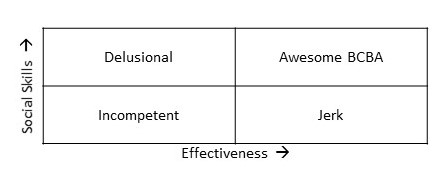In 2016, Behavior Analysis and Practice published an excellent article on the measurement of problem behavior called “A Proposed Model for Selecting Measurement Procedures for the Assessment and Treatment of Problem Behavior.” Blanc, Raetz, Sellers, and Carr present a model that behavior analysts can use to decide on the appropriate measurement procedure during the assessment and treatment of problem behaviors. The model captures many of the practical problems that can occur when selecting a measurement procedure, and is a useful contribution to the field. The article goes through all the basics on how to measure whether problem behavior is happening and how much it is happening. That’s obviously essential data to have, and the authors do an excellent job of going through a variety of problems that can occur when selecting a measurement procedure.
When I read this a couple of years ago, the first thing I thought about is how useful this model might be for training new behavior analysts. But second, I thought about how much more is needed to be successful in any practical situation. A good measurement procedure is necessary, but not nearly sufficient for practitioners. Obviously, including everything needed for a successful outcome would go way beyond the scope of this brief article. I’m not talking about successfully treating problem behaviors; just measuring the effects of treatment is a difficult undertaking.
So, what else is needed to measure successful treatment of problem behaviors besides knowing if the problem behavior is happening or not? In my view, at least five other measures are needed:
What else is he or she doing? –The Sit Down and Be Quiet Problem
Often, one of the primary outcomes that people want in a program based on the principles of applied behavior analysis is the absence of problem behaviors. Of course, that can be an important outcome, but it certainly matters what the person is doing instead of engaging in problem behaviors. Everyone is happy when significant self-injurious behavior or aggression is eliminated, but if the person is sitting around doing nothing much of interest, it likely isn’t a very valuable outcome. It is also essential that the person is doing something else that is beneficial to their well-being. Are they engaging in valuable communication, social skills, academic, or self-help skills? If not, it is hard to argue that much value was accomplished from the treatment.
What are the staff doing? –The Child Effects Problem
In research, what the staff or parents do during the treatment is very carefully monitored, but this rarely happens in practice in schools or homes. In the real world, staff usually have to make some “judgement calls.” This often leads to staff doing things to prevent problem behaviors that may or may not be in the child’s long-term best interest. Often, the child shapes the adult to avoid things they don’t want to do. The literature refers to this problem as child effects. If you don’t know about these things the staff are doing during treatment, maintenance and generalization of treatment effects is extremely unlikely. Therefore, it is absolutely essential to have some measurement of how well the treatment is being implemented. Not just for quality control, but to help with generalization and maintenance of the treatment effects.
Will this last over time? The Maintenance Problem.
A very common problem in the treatment of problem behavior is that at first, things work great, but over time, the behavior doesn’t last in the long run. From a measurement perspective, the problem comes when people say things like, “Since we haven’t seen any problem behavior in six months, we don’t need to measure problem behaviors anymore.” In about 99% of cases, people gain the weight back after the diet. We don’t really have data on how often the problem behavior comes back after successful treatment, but I can guarantee you it is a lot. Behavior analysts need to incorporate a maintenance plan with good data collection procedures in their programs.
Will this work in the real world? –The Natural Contingency Problem
There are many potential ways to reduce a problem behavior. Often, behavior plans are implemented over very long periods of time. That is appropriate and necessary most of the time. But eventually, parents and teachers want to live life without having to worry about managing the behavior all the time. If we want to achieve long-term maintenance, the child has to engage in an alternative behavior for a real-world reason that will meet a natural contingency. In other words, the appropriate alternative behaviors will be reinforced even if no one plans it out in advance. Eventually, we need to measure how the real world responds to the child’s alternative behaviors.
Are there hidden reasons treatment will fail? –The Social Validity Problem.
Not everything can be measured with objective data. For example, the teacher doesn’t agree with the treatment procedures; Grandma won’t follow the protocol; it isn’t practical at church; the paraprofessional hates the plan and does her own thing when no one is around. It is essential that we get the honest subjective judgements of all the people involved in the treatment. All the objective data might be showing great results, but if the important people in the child’s life still have significant concerns, it is only a matter of time before those issues start to show up in the objective data too.
In conclusion, the article “A Proposed Model for Selecting Measurement Procedures for the Assessment and Treatment of Problem Behavior” is a great place to start on measuring treatment for problem behavior. Just recognize that there is a lot more needed to be successful in practical settings.
